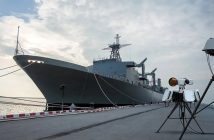
The French defence procurement agency (DGA) has chosen robotics company Exail to supply a new autonomous underwater vehicle (AUV) capable of operating at depths of up to 6,000 metres. As a result, the French Navy acquire its first sovereign ultradeep-sea exploration and surveillance capability.
The French 20230 investment plan highlighted that seabed control was shaping up as a major challenge for France’s defence, in particular, to ensure France’s sovereignty and freedom of action and protect its strategic and economic interests.
As part of the capability-building process set out in the Ministerial Strategy for Seabed Warfare adopted in 2022, the French Navy will extend its investigation and intervention capabilities using AUVs and remotely operated robots (ROVs).
The Exail underwater drone is based on the architecture of Ulyx, a AUV co-developed by it and Ifremer (French National Institute for Ocean Science and Technology ). Ulyx made its first dives to 6,000 metres during the autumn of 2023.
Building on the technological building blocks already developed for Ulyx, the planned AUV is an example of dual-use technology adapted to meet the specific needs of the French Navy. It will carry out reconnaissance and surveillance missions on the seabed, as well as on sensitive underwater infrastructures such as submarine cables.
“We are honored to have been chosen by the French government to develop this new 6000-meter AUV, which will enable the French Navy to carry out the strategy of the Ministry of the Armed Forces. We are extremely proud of this recognition of our technological expertise in seabed warfare and to contribute to strengthening national sovereignty”, said Exail’s Jérome Bendell.
Exail is a high-tech industrial company specialising in cutting-edge robotics, maritime, navigation, aerospace and photonics technologies.
The AUV, the legacy of over 40 years of Exail deep-sea experience, will incorporate a number of Exail-designed and manufactured components, including a Phins inertial navigation system and acoustic sensors. However, it will also be able to carry sensors from other suppliers in order to adapt the system to the missions to hand.





